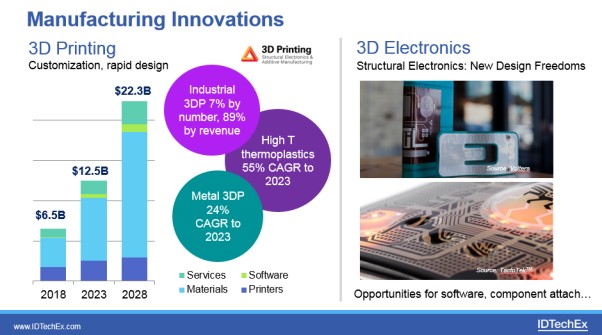What are the key trends for emerging technologies?
Last week while most of us this side of the pond were at the electronica exhibition in Munich, approximately 3,500 attendees from 42 countries headed to the IDTechEx Show in Santa Clara, California, which featured 284 exhibiting organisations. Raghu Das, CEO, IDTechEx, explains.
The event helps to bring together eight key technologies – 3D printing; electric vehicles; energy storage; graphene; IoT; printed electronics; sensors and wearables - with the organisations that seek to use them.
These co-located events, which in total featured 275 speakers, cover the full value chain allowing, for example, materials companies to understand the needs and challenges of OEMs and global brands so that they can build appropriate solutions; and enabling OEMs and global brands to see the emerging capabilities which allow them to differentiate their products.
Over-arching themes addressed at the event include the radically new design freedoms enabled by new form factors of electronics and electrics (such as flexible and even stretchable devices); the increasing ubiquity of electronics and connectivity in the form of IoT, sensors and wearables; and the increasing electrification of vehicles and the opportunities that result. New and improved functional materials were on show including many manufacturing innovations.
The following were among some of the key technology highlights covered at this year’s event, as presented in the opening presentation by IDTechEx CEO Raghu Das.
Printed, flexible, organic electronics
Key developments including the commercialisation of foldable displays, with Royole Corporation presenting on the first foldable smart phone coming to market in December 2018. JOLED covered the world’s first printed OLED display. Many companies presented on their progress in printed electronics as they move from being a component provider to a systems/solution provider, filling that gap in the value chain.
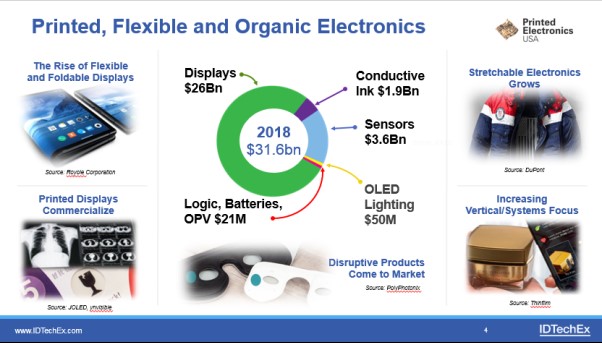
Sensors: Key trends
The event covered three key trends with sensors: miniaturisation; technology improvements that are driving volume growth in more applications and new form factors.
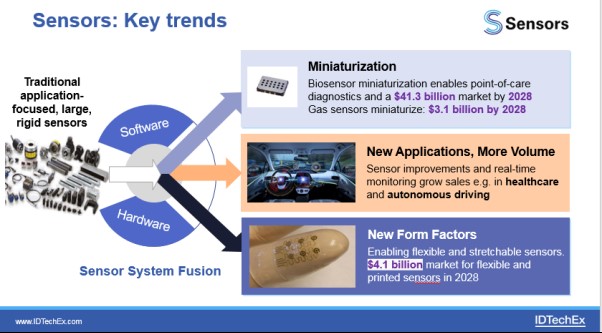
Wearables: Booming and changing
Over the last six years there has been tremendous growth in the wearable technology sector. For example, in 2013 smartwatches and fitness trackers were around $1bn in sales. In 2018, they are over $12bn. Electronic skin patches have grown to a $5bn industry with many in wearables focusing on mass market healthcare technologies, helped in part by changing regulations.
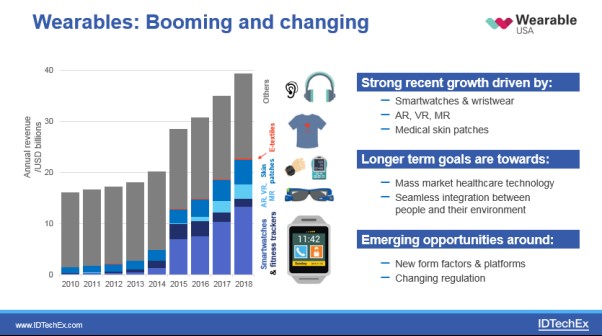
IoT applications and connectivity
The event featured case studies across many IoT applications, in addition to appraising the different technology options – from Low Power Wide Area Networks (LPWAN) to RFID deployment, with the latest IDTechEx numbers shown below.
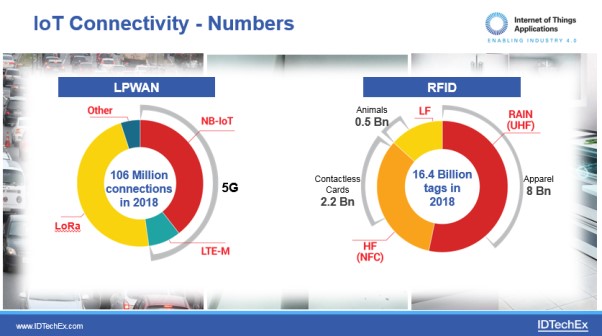
Electric Vehicles (EVs): The drama and opportunities
Due to global government action to move to electric vehicles and automakers responding to that in droves by developing electric vehicles, IDTechEx expects sales of internal combustion engine vehicles to peak around 2022. Additionally, thanks to car autonomy and government push to car sharing, IDTechEx forecast a peak in sales of all cars in 2030.
This all creates huge new opportunities: for materials (from thermal interface materials to structural electronics to light weighting); components (including sensors and connectivity); to complete new vehicle types such as electric shared passenger vehicles. Such topics were explored at the event.
See the full range of IDTechEx electric vehicle research here.
Energy storage: The cobalt rush
Winners in electric vehicles will be winners in energy storage, with OEMS vying for IP in energy storage dominance. The event also covered new innovations in energy storage including how new form factors of batteries and supercapacitors are enabling new products.
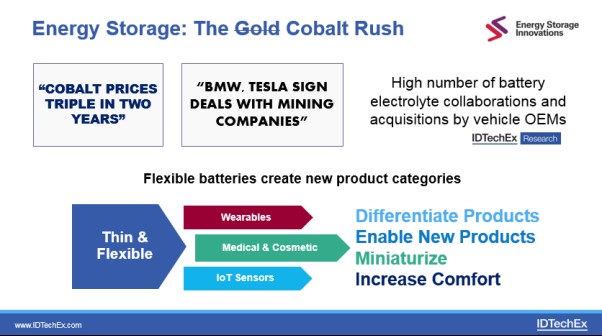
Progress with enabling materials
Many of the new capabilities highlighted at the event are enabled by advancements in materials. For example, new trends such as 5G is creating new opportunities for materials for EMI shielding due to the higher frequencies used. Stretchable conductive materials and substrates are part of a growing e-textile sector that will create a market worth over $2bn in 2028.
In addition to many materials that were covered, the event explored graphene in detail. There is now good global capacity to make graphene and suppliers are focused on realistic, short term markets. Prices have fallen and all this is leading to strong commercial interest – IDTechEx expects strong take-off in sales around 2021, creating a market nearing $350 million for the material in 2028.
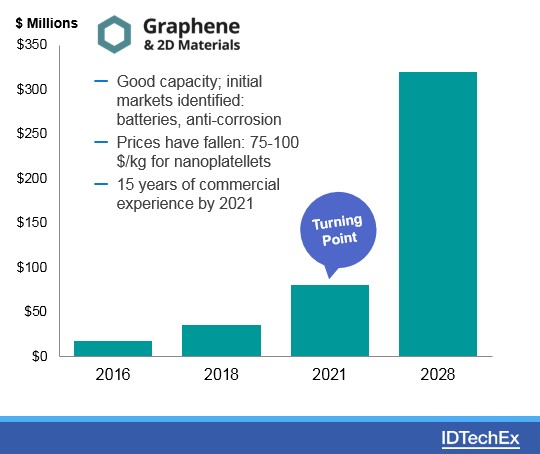
Manufacturing innovations
In addition to materials the event also covered the new manufacturing innovations. 3D Printing is one focus of this event, with the industry growing from $6.5bn in 2018 to $22.3bn in 2028.
3D printed materials are a large part of the market value, showing strong growth – such as high temperature thermoplastics which are the fastest growing material type in the 3D printed polymer category at 55% CAGR to 2023.
Then there are also other processes enabling 3D electronics - bringing vastly new design freedoms including light weighting, space saving and other benefits such as ability to customise designs more easily in some cases. These offer radical new opportunities for product designers.
